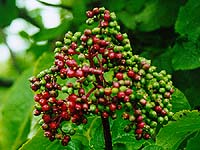The Honeysuckle Family
 |
 |
| Lonicera japonica
|
Caprifoliaceae, Honeysuckle
|
The Caprifoliaceae family is comprised of 12 genera and 450 species. Its distribution is mainly
temperate to subtropical in the Northern Hemisphere. The most diversity is found in North America and
eastern Asia. The major genera are Lonicera and Abelila. The plants are generally shrubs to woody vines. The family is broken into three to four tribes
based on carpel number and fruit type.
Click here for a distribution map of the Caprifoliaceae in the U.S.A.
Vegetative Characters | Reproductive Characters |
Diagnostic Characters | Economic Importance/Fun Facts
| Evolutionary Adaptations and Relationships | Glossary of Terms |
References and Links | Pictures
- shrubs or woody vines sometimes lianas
- simple opposite leaves can be entire to serrate
- contains iridoid compounds and saponins
Back to top
- flowers zygomorphic, perfect and epigynous
- inflorescence determinate and variable
- calyx synsepalous with 4 to 5 lobes or teeth
- corolla sympetalous with 4 to 5 lobes
- corolla often bilabiate sometimes basally spurred
- glandular hairs on inside of corolla
- 4 to 5 epipetalous stamen with distinct filaments
- 2 to 5 carpels
- inferior ovary
- unitegmic and tenuinicellate ovules
- usually has as many locules as carpels
- placentation axile or axile at base and parietal at apex with incomplete septa
- fruit berry, drupe or achene
Back to top
- simple opposite leaves
- flowers sympetalous and zygomorphic, constricted below calyx lobes
- flowers showy and tubular
- usually 5 connate petals- 2 upper and three lower or 1 upper and 4 lower
- dorsifixed, versatile anthers
- 2-5 carpels
- inferior ovary with several carpels aborting
Back to top
- ornamentals- honeysuckle, beautybush, twinflower, coral-berry
- invasive weeds
Back to top
- monophyly is in doubt
- generally placed in the Dipscales along with the Adoxaceae
- Linnaeeae is the best supported clade for monophyly
- may be merged with Valerianaceae and Dipsacaceae due to floral anatomy
and aborting of ovules
- zygomorphic (bilateral) flowers are a synapomorphy
- large spiney pollen is a synapomorphy
- glandular hairs on lower part of corolla tube produce nectar is a synapomorphy
Back to top
- dorsifixed- attached at the back
- versatile- (anther) attached to its filament at the middle, usually moves freely
- iridoid- bitter tasting compounds
- saponins- toxic plant glycosides, foam when shaken with water
- unitegmic- ovule with single integument
- tenuinicellate- nucellus that consist of 1 layer of cells
- nucellus- inner part of ovule
Back to top
- Judd et al., 1999. Plant Systematics: a phylogenetic approach. Sinauer Associates, Inc. Sunderland, MA U.S.A.
- Zomlefer, Wendy B., 1994. Guide to Flowering Plant Families. The University of North Carolina Press Chapel Hill, NC USA.
Back to top
 |
 |
| Heptacodium miconioides flowers |
Twinflower
Linnaea borealis
|
 |
 |
| Sambucus racemosa racemosa
Red Elderberry
Caprifoliaceae (Honeysuckle Family) |
CAPRIFOLIACEAE Lonicera alpigena |

Back to top
For questions or feedback, contact:
Catharine Calandra






